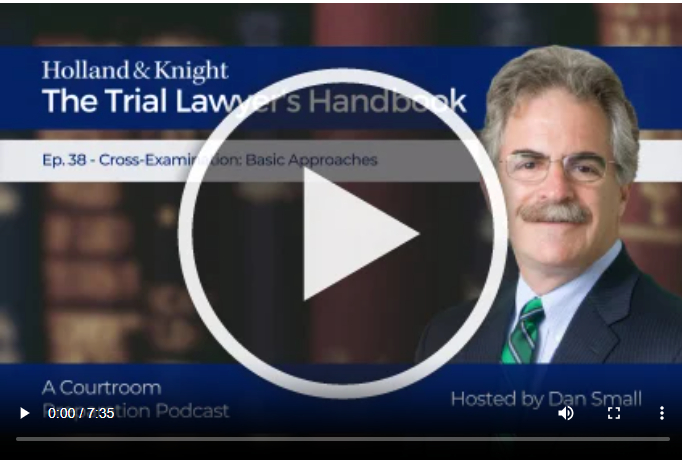In this episode of "The Trial Lawyer's Handbook" podcast series, litigation attorney Dan Small outlines nine basic approaches attorneys can incorporate when conducting a cross-examination. He encourages listeners to take all nine into account and think critically about how to combine and structure various approaches for an effective cross-examination.
Listen and subscribe on Amazon.
Listen and subscribe on Apple Podcasts.
Listen and subscribe on SoundCloud.
Listen and subscribe on Spotify.
Watch and subscribe on YouTube.
Mr. Small is also the author of the new American Bar Association (ABA) book Lessons Learned from a Life on Trial: Landmark Cases from a Veteran Litigator and what They Can Teach Trial Lawyers.
Podcast Transcript+
Dan Small: The classic image of cross-examination is of a slash and burn attack on a witness' credibility. But there are many different ways to conduct a cross and lots of ways in which things can go wrong. So think carefully about what you hope to accomplish, what you reasonably can accomplish and how you plan to get there before you ask your first questions. Let's look at the different approaches you can take on cross. Of course, you're not limited to just one, and a lot of the time you'll use a combination. Think about which one comes first.
Number one, elicit favorable testimony, if any. Even hostile witnesses sometimes have helpful things to say. Don't forget to ask. Constructive cross can be surprisingly effective because any positive testimony from the other side's witness may have the added luster to appear to be an admission.
Number two, sidestep the witness' testimony. Proving that someone is a liar is hard. Trying and failing to prove it can be damaging to your case. So ask yourself, is it possible and is it necessary? Sometimes you can show that what the witness said doesn't really matter. This is common with an expert witness. The expert opinion may depend entirely on a factual assumption that may prove to be wrong, but there are lots of other circumstances in which you can sidestep or deflect the witness' testimony, rather than attack it head on.
Number three, limit the witness' testimony. Emphasize the limitations of the testimony: what he or she did not see, hear or do. Maybe the witness wasn't actually at the critical meeting or didn't actually observe the accident. The witness may have said so on direct, but it may have been glossed over by the lawyer for the other side. Emphasize it on cross to make sure that the jury gets it.
Number four, ask about what did not happen. Often an important goal of cross-examination is to point out things that should have happened but didn't. This may require some imagination. As you are preparing your cross, visualize how events or things should have or might have unfolded and compare them to the available evidence. Here's a famous example from "Silver Blaze," a Sherlock Holmes story involving the midnight disappearance of a valuable racehorse from a stable. Inspector Gregory of Scotland Yard asks Holmes, "Is there any point to which you wish to draw my attention?" And Holmes says, "Yes, to the curious incident of the dog in the night time." Inspector Gregory says, "Well, the dog did nothing in the night time." And Holmes replied, "That was the curious incident. It turns out that the horse was surreptitiously removed by its own trainer." As Holmes later explains, a dog was kept in the stables. And yet, although someone had been in and out and had fetched out a horse, the dog had not barked enough to arouse the two lads in the loft. Obviously the midnight visitor was someone who the dog knew well. Like Holmes, don't limit yourself to what evidence is there. Think about what evidence is not there, but should be.
Number five, cast doubt on the witness' ability to perceive. Show that the witness' ability to see, hear or remember should be doubted or discredited. In a great scene in the movie "My Cousin Vinny" that I use when I teach trial advocacy, Joe Pesci's character uses a tape measure and two fingers to convince an eyewitness and the jury that the witness needs thicker glasses. But limits on perception can take many forms. Suppose a police officer testifies about seeing something from a parked automobile on a surveillance detail. Obviously, defense counsel would want to consider basic facts like the distance and the lighting. But other details might also matter, such as whether the car windows were tinted, or whether the officer had worked multiple overtime shifts and was likely fatigued.
Number six, show that the witness may not remember accurately. Litigation takes a long time, and trials often take place months or years after the events in question. Memories fade, and memories often transform as they are subject to things like hindsight, bias and suggestibility. What a witness genuinely believes is an accurate memory may in fact be substantially distorted by the time of trial.
Number seven, show that the witness is mistaken. Show that the witness is not lying, he or she simply got it wrong. People are human and they make mistakes. Everyone understands that. Jurors may have trouble believing that a polite and respectful law enforcement officer or a sweet little grandmother is deliberately lying. But you might be able to convince them that that witness is just mistaken. It happens.
Number eight, show that the witness is exaggerating. Exaggeration is a form of untruth, but it's usually much less deliberate. People say things like, it rained every day on our vacation, goodness gracious, when what really happened is that it rained for three days and part of a fourth out of a full week. They aren't lying in the conventional sense. They're trying to emphasize a point and tell a good story. You may need to let a little air out of the witness' story. Sometimes witnesses will quickly concede that they aren't being as precise and careful as perhaps they ought to be.
Number nine, show that the witness is lying. Sometimes witnesses do lie. If they do, and it matters, and you can prove it, you may have to go on the attack. Never assume that an all-out attack on a witness' credibility is the best or only approach. It may well be, but consider the other options first.
The content of this article is intended to provide a general guide to the subject matter. Specialist advice should be sought about your specific circumstances.
We operate a free-to-view policy, asking only that you register in order to read all of our content. Please login or register to view the rest of this article.


